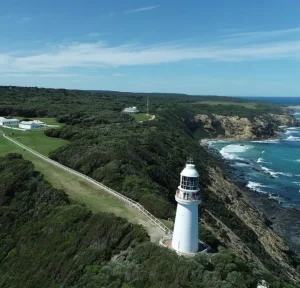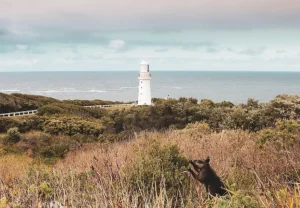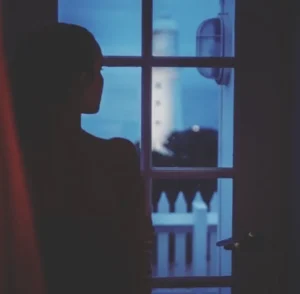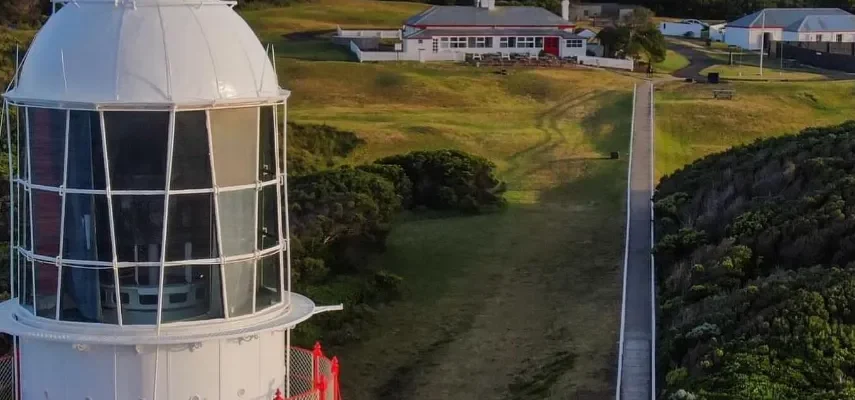The Cape Otway Lightstation is a treasure along the Great Ocean Road near Apollo Bay. A fascinating piece of history and stunning views. The oldest working lighthouse on mainland Australia has been watching over the coastline for over 170 years, guiding ships through the treacherous Southern Ocean and Bass Strait. Located in Cape Otway National Park, perfect for road trips, nature walks and a journey through Australian maritime history.
A Lighthouse with a Story

Built in 1848 the Cape Otway Lighthouse was a response to the many shipwrecks that plagued the “Shipwreck Coast”. This stretch of coast earned its name for a reason – hundreds of lives were lost in the waters before the lighthouse was built. Its position near Blanket Bay, Aire River and Parker River provided much needed guidance to sailors and saved many lives over the years.
The lighthouse has a fascinating history tied to the early settlement of Australia, particularly during the height of immigration in the 19th century. Ships carrying hopeful settlers would sail past Cape Otway, the first land sighted after long journeys across the globe. The lighthouse was a symbol of hope and a new beginning for thousands of immigrants.
Today, you can step back in time by walking the lighthouse grounds and the 1859 telegraph station. This was a critical link in Australia’s communication network, connecting the mainland to Tasmania via an undersea cable. Charles Joseph La Trobe, an early administrator of Victoria, was involved in the development of the lighthouse and its buildings, and you can read about his efforts to preserve Australia’s coastal heritage.
Lighthouse Surrounds

The Cape Otway Lightstation is not just historic; it’s also surrounded by some of the most beautiful natural scenery on the Australian coast. The lightstation sits on cliffs with views of the Southern Ocean where you can see whales, dolphins and seals. The rugged coastline against the lush Otway Ranges forest is a nature and photography lover’s dream.
As part of Parks Victoria, the National Park surrounding the light station is protected, and there are many walking tracks to experience the natural beauty of the area. The area is famous for its tall forests, coastal scrubland and beaches, including Shelly Beach, Wreck Beach and Johanna Beach. Whether you’re doing the Maits Rest Rainforest Walk, walking through the Redwood Forest or hiking to Melba Gully, the landscape around Cape Otway is a nature lover’s heaven.
For waterfall enthusiasts, the area has several waterfalls, including Triplet Falls, Hopetoun Falls, Beauchamp Falls, Rainbow Falls and Phantom Falls. The walks to these waterfalls take you through dense myrtle beech forests and fern filled gullies and is an immersive experience of the rainforest that is the Otway Ranges.
Walking Tracks and Secluded Beaches

The walking tracks around the Cape Otway Lightstation are varied and suit all fitness levels. For a easy walk the Maits Rest Rainforest Walk is a short walk through a beautiful forest with tall trees and a vibrant forest floor. For the more adventurous the Great Ocean Walk stretches for over 100km along the coast and offers dramatic views and access to secluded beaches like Milanesia Beach and Johanna Beach.
Other tracks to try are the Phantom Falls Walk (from The Canyon), Crayfish Bay Track and Bracks Access each offer different views of the coastal cliffs and cliff tops. These walks often reward you with beaches, coastal forest and panoramic views of the Southern Ocean.
As well as walking, Cape Otway National Park is a great place to camp. Aire River East Campground, Aire River West Campground and Parker Hill Campground are the perfect spot to camp and experience the peace of the Otways. Drive-in camps and hiker camps are available.
Wildlife and Indigenous History
The area is full of wildlife, and Parks Victoria rangers are looking after the land to protect it. Koalas are often seen in the coastal forests around Kennett River. Kangaroos, wallabies and many bird species are also in the area. If you’re lucky, you might even see some of the more elusive creatures, like echidnas or rare bird species, as you walk around the Sheoak Picnic Area, Blanket Leaf Picnic Area or Aire River Visitor Area.
The indigenous history of the area is just as interesting as the maritime history. The traditional custodians of the land, the Gadubanud people, have lived in the Otways for thousands of years and you can learn more about their culture and connection to the land at the nearby Indigenous Cultural Centre.
Stay Overnight at the Lighthouse Keeper’s Cottage

If you want to be fully immersed in the history and natural beauty of Cape Otway, staying in the Heritage Accommodation at the lighthouse grounds is a must. The original lighthouse keepers’ cottages have been converted into comfortable accommodations where you can experience what it was like to live in the shadow of the lighthouse. Waking up to views of the Southern Ocean and hearing the waves crashing against the coastal cliffs is a peaceful and unforgettable experience.
Bookings are recommended in advance, especially during peak season. Staying overnight also gives you the chance to explore the lighthouse and surrounding walking tracks without the crowds that come during the day.
Local Attractions and Day Trips

If you have time, the Otways is full of other attractions that are worth staying on for. Apollo Bay is just a short drive away and is a beautiful coastal town with a great food scene and the perfect base to further explore. Stop in at the Apollo Bay Distillery for a taste of local gin or browse the town’s shops and galleries.
Lavers Hill is a small village in the heart of the Otways and is a great place to stop for a meal. It has walking trails to waterfalls and coastal forests nearby. Dinosaur Cove is just a short drive away and offers a glimpse into Australia’s prehistoric past, where dinosaur fossils were found on the cliffs.
For a scenic drive, Lightstation Road and the Great Ocean Road are the perfect routes, with many lookouts and places to stop along the way. Whether you’re here for a day trip or an extended road trip through the Otways, Cape Otway Lightstation has it all – Australian history, natural beauty and adventure. Experience the beauty of the Otways with our Great Ocean Road Tour. Visit Apollo Bay, indulge in local gin at the distillery, and explore rainforest trails leading to stunning waterfalls. Adventure awaits!
FAQ
How do I get to Cape Otway Lightstation?
Cape Otway Lightstation is just off the Great Ocean Road from Apollo Bay. From Apollo Bay, follow Lighthouse Road for 30km, and you’ll be at the lighthouse grounds.
Can I camp near Cape Otway Lightstation?
Yes, there are several campgrounds nearby including Aire River East Campground, Aire River West Campground and Parker Hill Campground. These sites have a range of campsites from drive-in to more remote hiker camps.
What are the main walking tracks near Cape Otway Lightstation?
Maits Rest Rainforest Walk, Triplet Falls, Phantom Falls and the Great Ocean Walk are the main walking tracks. These tracks vary in difficulty and length so there’s something for every level of walker.
Can I stay overnight at the Cape Otway Lightstation?
Yes, the lighthouse keepers cottage offers Heritage Accommodation where you can stay and enjoy the history and scenery of the area.
What wildlife?
Koalas, kangaroos, wallabies and many birds. Whales and dolphins during migration season.
